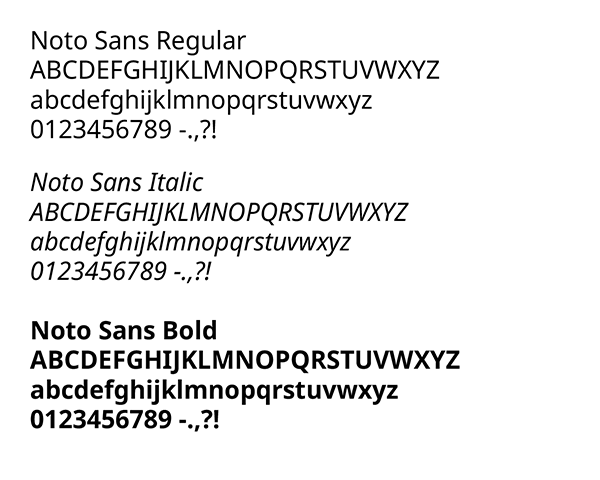Font
Font
Arial is now the mandatory Tasmanian Government corporate font. The previous font family, Gill Sans does not meet accessibility requirements and is therefore no longer to be used. Arial is freely available on Tasmanian Government issued devices and must be used for internal and external publications (including documents, posters, email and even email signatures).
Alternatively, Noto Sans can be used for professionally designed documents – produced internally or externally. This font can be activated through Adobe fonts.
All templates using any of the Gill Sans font family or other non-authorised or premium fonts must be updated by 31 December 2024.
Any new documents must use Arial or Noto Sans unless otherwise approved. Pre-existing and current documents should be replaced in a timely manner with external facing documents a priority.
Any other assets should be updated in line with agency asset replacement schedules.
New templates using Arial that comply with the policy requirements are available from the toolbox.
These templates are not mandatory for use across government but can be used to guide the development of individual agency templates and other collateral considering accessibility requirements.
Exemptions
- these fonts apply unless an exemption and any applicable licensing has been obtained
- to apply for an exemption, speak with your Agency’s Communications Manager in the first instance.
Corporate fonts
Arial
This font is readily available on Tasmanian Government issued computers. Font hierarchy and best practice styles, including point sizes, are illustrated in the new corporate templates.

Noto Sans
Noto Sans font can be used for professionally designed documents only. This font can be accessed through Adobe fonts.
Note: Avoid the use of Noto Sans thin and light cuts due to potential accessibility issues.

Arial and Noto Sans use is not limited to the three displayed styles. Further weights (styles) within the font family can be used. This excludes any condensed and/or rounded font styles - this is considered a different font family. Please consider accessibility when choosing a font weight.
Exemptions
- For font exemptions please contact the Communications Unit in the Department of Premier and Cabinet via email: communications@dpac.tas.gov.au
Font use
Templated documents
For all templated Tasmanian Government documents produced for internal use, Arial must be used.
Templated documents refer to document templates prepared by each department or entity using Microsoft Office software (including Word, PowerPoint and Excel).
Templates prepared by DPAC Communications can be used by all Tasmanian State Service (TSS) employees but they are not mandatory. Templates are available from the toolbox.
In addition, each agency’s communication team can oversee the adjustment of the TSS templates to meet their needs and approved brand identity.
Professionally designed documents
Professionally designed Tasmanian Government documents must use Arial or Noto Sans unless an exemption is provided by the DPAC Communications Unit and the appropriate licensing has been obtained by the relevant agency.
Professionally designed documents are documents that are developed by a design professional (TSS staff or external contractor) and may include, but are not limited to, annual reports, strategic plans, strategies and discussion papers.
Font size
All government communications material must meet accessibility standards. A minimum of 12pt body copy and appropriate line spacing is recommended for easy readability.
Heading font sizes are flexible but should exceed the body copy size of 12pt.
Font size in professionally designed documents, newsprint and advertising, may be varied due to space and budget constraints. However, please consider alternative methods of advertising or providing the same information in an alternative and accessible format if your font size is required to be less than 10pt.
Typography
To ensure information is accessible, please:
- use white space, clear space is important to visually divide big blocks of text
- create a logical, easy-to-follow structure
- provide space between lines of text
- avoid using words in all uppercase because readability is reduced, words take on a uniform rectangular shape
- do not underline text, reserve underlining for links
- use left-aligned text, a consistent left margin makes reading easier
- do not use double spaces after a sentence
- do not use italics, except when writing the names of documents, referring to legislation or Latin names
For additional information about document accessibility.
Web fonts
Web fonts
Tasmanian Government websites must use a readable and accessible sans-serif web font (for example Open Sans). Fallback fonts must be generic sans-serif.
Please:
- ensure appropriate letter-spacing and kerning for optimal readability
- prioritise balanced proportions, clear letterforms, and avoid overly decorative designs that hinder legibility and intended communications
- verify a clear distinction between similar characters, adequate contrast ratio, size scalability, and Web Content Accessibility Guidelines (WCAG) compliance.
Choose sans serif fallback fonts that are readily available, with appropriate licensing, allowing free or unrestricted use.
Examples include open-source licenses like SIL, Open Font License (OFL) or Apache License.
Verify the font includes a comprehensive range of special characters and supports Latin extended as required (for example accented characters).
Font-family suggestions are:
- Open Sans
- Arial
- Helvetica
- Noto Sans.
A fallback font must:
- have a pixel-width and kerning resembling the font of choice
- be set to sans-serif.
Font licensing
When using copyrighted works or licensed products, (e.g. images, photographs and fonts) it is the responsibility of the individual agency producing and/or in charge of producing marketing or promotional materials to ensure compliance with the Commonwealth’s Copyright Act 1968 and other relevant laws. This includes but is not limited to obtaining any required licences, permissions and/or including any acknowledgements.
The fonts included in this Policy have been selected to minimise the need to purchase additional licences and reduce the risk of copyright infringement.
Importantly, if an agency decides to use a different font for a specific purpose, that agency must ensure the correct additional licence(s) is purchased for the specific use of that font.
